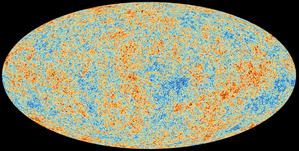Glossary term: Cosmic Microwave Background (CMB)
Description: The cosmic microwave background (CMB) is the relic electromagnetic radiation from when the Universe was about 380,000 years old and became transparent to light. It provides information about the Universe’s composition, geometry (shape), evolution, and development of structure. The early dense Universe, consisted of a "hot soup" of free particles (protons, neutrons, electrons) and light (photons). Before the CMB was released, the interaction of photons with free electrons prevented light from traveling long distances. The expansion and cooling of the Universe allowed free electrons to combine with protons to form atomic hydrogen, and allowed light to travel through the Universe. The expansion has subsequently stretched the wavelength of these photons, making them detectable today in the microwave region of the electromagnetic spectrum.
Related Terms:
See this term in other languages
Term and definition status: This term and its definition have been approved by a research astronomer and a teacher
The OAE Multilingual Glossary is a project of the IAU Office of Astronomy for Education (OAE) in collaboration with the IAU Office of Astronomy Outreach (OAO). The terms and definitions were chosen, written and reviewed by a collective effort from the OAE, the OAE Centers and Nodes, the OAE National Astronomy Education Coordinators (NAECs) and other volunteers. You can find a full list of credits here. All glossary terms and their definitions are released under a Creative Commons CC BY-4.0 license and should be credited to "IAU OAE".
If you notice a factual error in this glossary definition then please get in touch.
Related Media
Cosmic Microwave Background Radiation
Credit: ESA/Planck Collaboration credit link
License: CC-BY-SA-4.0 Creative Commons Attribution-ShareAlike 4.0 International (CC BY-SA 4.0) icons









